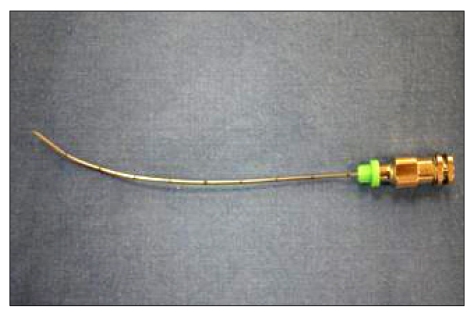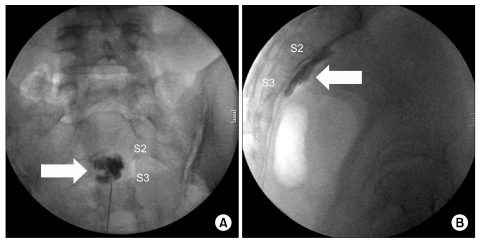Korean J Pain.
2012 Jan;25(1):38-42. 10.3344/kjp.2012.25.1.38.
A New Technique for Inferior Hypogastric Plexus Block: A Coccygeal Transverse Approach: A Case Report
- Affiliations
-
- 1Department of Anesthesiology and Pain Medicine, The Catholic University of Korea College of Medicine, Seoul, Korea. demoon@catholic.ac.kr
- KMID: 2278114
- DOI: http://doi.org/10.3344/kjp.2012.25.1.38
Abstract
- Chronic pelvic pain is a common problem with variable etiology. The sympathetic nervous system plays an important role in the transmission of visceral pain regardless of its etiology. Sympathetic nerve block is effective and safe for treatment of pelvic visceral pain. One of them, the inferior hypogastric plexus, is not easily assessable to blockade by local anesthetics and neurolytic agents. Inferior hypogastric plexus block is not commonly used in chronic pelvic pain patients due to pre-sacral location. Therefore, inferior hypogastric plexus is not readily blocked using paravertebral or transdiscal approaches. There is only one report of inferior hypogastric plexus block via transsacral approach. This approach has several disadvantages. In this case a favorable outcome was obtained by using coccygeal transverse approach of inferior hypogastric plexus. Thus, we report a patient who was successfully given inferior hypogastric plexus block via coccygeal transverse approach to treat chronic pelvic pain conditions involving the lower pelvic viscera.
Keyword
MeSH Terms
Figure
Reference
-
1. Campbell F, Collett BJ. Chronic pelvic pain. Br J Anaesth. 1994; 73:571–573. PMID: 7826779.
Article2. Schultz DM. Inferior hypogastric plexus blockade: a transsacral approach. Pain Physician. 2007; 10:757–763. PMID: 17987098.3. Zondervan KT, Yudkin PL, Vessey MP, Dawes MG, Barlow DH, Kennedy SH. Prevalence and incidence of chronic pelvic pain in primary care: evidence from a national general practice database. Br J Obstet Gynaecol. 1999; 106:1149–1155. PMID: 10549959.
Article5. Ku JH, Kim SW, Paick JS. Quality of life and psychological factors in chronic prostatitis/chronic pelvic pain syndrome. Urology. 2005; 66:693–701. PMID: 16230119.
Article6. Zabihi N, Mourtzinos A, Maher MG, Raz S, Rodríguez LV. Short-term results of bilateral S2-S4 sacral neuromodulation for the treatment of refractory interstitial cystitis, painful bladder syndrome, and chronic pelvic pain. Int Urogynecol J Pelvic Floor Dysfunct. 2008; 19:553–557. PMID: 17925994.
Article7. Moore J, Kennedy S. Causes of chronic pelvic pain. Baillieres Best Pract Res Clin Obstet Gynaecol. 2000; 14:389–402. PMID: 10962633.
Article8. Breivik H, Collett B, Ventafridda V, Cohen R, Gallacher D. Survey of chronic pain in Europe: prevalence, impact on daily life, and treatment. Eur J Pain. 2006; 10:287–333. PMID: 16095934.
Article
- Full Text Links
- Actions
-
Cited
- CITED
-
- Close
- Share
- Similar articles
-
- Unilateral, Single Needle Approach Using an Epidural Catheter for Bilateral Superior Hypogastric Plexus Block
- Transdiscal Superior Hypogastric Plexus Block with the Patient in Oblique Position
- Three Cases of Transdiscal Superior Hypogastric Plexus Block
- Transdiscal Superior Hypogastric Plexus Block for Postparaplegic Pelvic Pain
- Trans-intervertebral Disc Approach of Superior Hypogastric Plexus Block for Pelvic Cancer Pain A Retrospective Study




